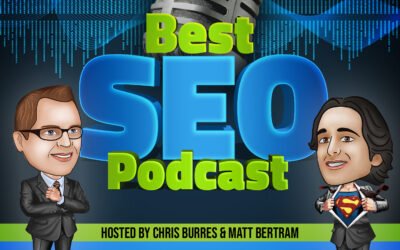

Follow Us On Youtube
Video Transcript
This feature will be available soon!
TRANSCRIPT:
Chris Burress:
Hi and welcome to the SEO podcast, Unknown Secrets of Internet Marketing. My name is Chris Burris, owner of eWebResults.
Matt Bertram:
My name is Matt Bertram, party crasher.
Chris Burress:
He is a party alien crasher, check out-
Matt Bertram:
Hashtag-
Chris Burress:
That’s #partycrasher.
Matt Bertram:
Well, I just got back from New Mexico, so I checked out Roswell. There was a [inaudible 00:00:25] took this out. I didn’t show you this.
Chris Burress:
Oh, you got an alien socks on also. Wow, that’s alien-ish.
Matt Bertram:
And you’re wearing like a Star Wars [inaudible 00:00:35]-
Chris Burress:
We’re like an entire space episode. This is kind of very cool.
Matt Bertram:
Yeah.
Chris Burress:
All right. So remember, we are broadcasting live here from Houston, Texas. And Matt and I, we are your results rebels-
Matt Bertram:
Invaders.
Chris Burress:
Results invaders. That’s not bad.
Matt Bertram:
Results rebels.
Chris Burress:
Hey, I want to jump into this review. It’s a little bit long, so I’m going to read it pretty fast. Yeah, go ahead and take a drink. It’s a little bit long.
Chris Burress:
[inaudible 00:01:01], Don’t spit. It’s from Alexandra Schmidt. And it is, of course, five stars. It says, “You guys are absolutely amazing. I’ve been listening to the podcast on Spotify. I love that you’ve been doing these for so long. Talk about a binge!”
Chris Burress:
Eh, that’s cool. Binge watching … or listening. “I wanted to say thank you for sharing your knowledge and experiences, and helping educate not only web SEO and marketing professionals, but also the general public. I’ve heard you say that your clients are sometimes coming to you after being burned by other companies, and that is an unfortunate reality for most of us. But hearing you guys talk about, and recommend, the things we do day in and day out in our office for our clients is inspiring. I know we are doing the right things. I hope business owners that listen realize that many of us do care and are avidly working for their success.”
Chris Burress:
By the way, it sounds like there’s an office of people behind Alexandra, so that’s awesome.
Matt Bertram:
Yeah, that’s cool.
Chris Burress:
Very cool. “With that said, I am hoping you could offer me some advice. There was one episode where you covered how to help your clients close more sales. And I wish you could have talked about it for another hour. You see, we have successfully moved one specific client up in search results, generating more clicks at a better cost in AdWords, have a strong social media marketing strategy, but they are not closing sales. Help me please. I don’t know if I should offer to sit in for a day … To sit in for a day to listen, to help with their sales process, plan guerilla marketing days, send emails daily, or it’s …”
Chris Burress:
And she’s saying, “It’s a local plumbing company for reference. And they have been very particular about sharing information, like who their happy customers are so we can get them on an email list and ask for referrals and reviews. Any advice you could bestow would be forever appreciated. Alex.” She goes by Alex. Punched in the face to you, Alex. She’s with Voyager Marketing. So punch in the face for all that. Yeah, and we do sit in with our clients, where we’ve gotten them good positions, and they’re with the conversions, and we’ve had to give very [crosstalk 00:03:01] guidance.
Matt Bertram:
Well, so yeah… Just a little advice there. And also with plumbing, it’s just funny, I had a client come in for plumbing and we did a handshake deal. Put him in first position-
Chris Burress:
In Houston.
Matt Bertram:
In Houston. So if you type in “plumber Houston”, whoever’s in first position, that’s us. Yeah, but bottom line is with selling, yes, the customer experience is very, very important. We’re actually moving to some audio files that play when people are put on hold-
Chris Burress:
On our phone system, yeah.
Matt Bertram:
On our phone system, to cross sell different products. I think the customer experience is very, very important. But if you’re using some kind of phone tracking system, we used to use CallRail. We’ve started to kind of move away from that because the data that the API is giving us is not everything we need, but you know, something like CallRail, you can listen to the calls there, and provide feedback.
Matt Bertram:
We do have our account managers listen to the calls and provide that feedback, and in some cases we’ve even written scripts. We’ve created step processes, like a sales step or tiered funnel to help them bring the clients in, because the sales person or business owner is usually going to do a better job selling than someone that they just hired. And so, that training’s important. You can provide them some framework, listening to the calls and providing that to the owner really opens their eyes a lot of times.
Chris Burress:
Right.
Matt Bertram:
And so, yeah, I think that the line between sales and marketing is getting blurred, and there’s definitely more you can do.
Chris Burress:
Yeah. And anytime you can add value to your clients, they appreciate it. It makes you feel good. It makes you more likely to keep the customer.
Matt Bertram:
Yeah, absolutely.
Chris Burress:
So yeah, if you’ve got any specific questions, or thoughts, or ideas, we’d be happy to entertain those-
Matt Bertram:
Yeah, you can sign up for a profit plan. We’re also going to be doing our first mastermind group. We’ve just finished that page, so we’ll be putting that up.
Chris Burress:
Oh wow, good.
Matt Bertram:
And so that’ll be in-depth training on how to actually run an agency. So, you know, we’re going through some of that sort of thing, and then we’ll be doing some different modules on social media, PPC, that sort of thing. To just provide more in depth knowledge in a training setting. I’ll also be doing some webinars and that sort of thing. So-
Chris Burress:
Keep your eyes peeled.
Matt Bertram:
Yeah, just keep your eyes peeled.
Chris Burress:
Keep your eyes peeled. All right. So if this is the first time you’ve listened to our podcast, howdy and welcome to the podcast. If you’ve listened to this podcast before, you might be interested in some tips, some strategies, some tricks. You can get, I don’t know, maybe 20 tips for an awesome web design. Top 10 SEO tips, five mistakes that could tank your business.
Matt Bertram:
Ninja tricks.
Chris Burress:
Ready to learn our Ninja tricks, right? That’s on the screen right behind us. You can get those just by going to ewebresults.com/tips. Go ahead and get over there.
Chris Burress:
We’re actually going to cover an article today. Well, half of an article today. 14 Ranking Signals You Need To Optimize For In 2019. This is from Aleh Barysevich. We’ve covered some of his articles in the past, so punched in the face to you, Aleh. He makes really good articles. So, let’s see. We’ve done the howdy. [inaudible 00:06:24] shirt, not your shirt-
Matt Bertram:
We’ve done the howdy.
Chris Burress:
Not your shirt, but my shirt. So if you look, my shirt right here, this is a … What is it? ‘SEO Results’, right? With kind of a Star Wars theme. You can get that at our website. Actually at our swag page. Ironically, or not ironically, called ewebresults.com/swag. By the way, on the back, it says, “May the rank be with you”. So it’s just-
Matt Bertram:
It is not a Star Wars page.
Chris Burress:
No.
Matt Bertram:
It is not that at all.
Chris Burress:
No, no, no. It has a vague resemblance, and anyone would recognize that it’s totally different.
Matt Bertram:
Yeah, totally different.
Chris Burress:
It’s not.
Matt Bertram:
Yeah. There’s no copyright issues at all.
Chris Burress:
Yeah. So that’s there.
Chris Burress:
All right, let’s jump into this. Again, 14 Ranking Signals You Need To Optimize For in 2019. Aleh Barysevich. And so the first thing, he’s kind of broken these into three categories. The first category is relevance.
Matt Bertram:
Yes.
Chris Burress:
I guess it’s more than obvious for any SEOs out there, and that’s you guys, that Google is going nuts about getting into people’s heads and providing them with the most relevant search results. We’ve been saying from the beginning on the podcast, if you deliver great value to the Google user, then Google will be very appreciative of you.
Matt Bertram:
So I want to kind of speak to that, right? So I think, you know, that cannot be stressed enough, how much content plays into SEO. It should be your North Star. You’ve got to have a really good piece of content. So all the other things that you do, go back to the content. Okay, so there’s 250 plus ranking factors. There’s all kinds of little things that you can do, but you have to have a quality piece of content that answers the user’s question. Like, “What is the price?”
Chris Burress:
And what he’ll cover, what Aleh will cover in this is, it needs to answer it comprehensively.
Matt Bertram:
Yes.
Chris Burress:
Yeah.
Matt Bertram:
So, let’s get into it.
Chris Burress:
Yeah, let’s get into it. Google also considers such factors as user search patterns, search history, location, and time. So those are all very important. So number one in the relevance category is “accordance to search intent.” When searching, users have certain intent, right? So you go out there and you do a search, your intent is to find a piece of information, find a restaurant, to read reviews. So you have an intent. So Google’s working really hard to try and understand what that intent.
Matt Bertram:
Well, so to just go into a little bit more on intent, not to take too long. But really-
Chris Burress:
You have 10 seconds.
Matt Bertram:
All right. All right, so when you’re talking about user’s intent, there was a study done years and years ago that basically talks about what are user’s intent online. And user’s intent is about 80% searching for some kind of information. So big picture, you know, only 10% of people are ready to buy something. A lot of people are optimizing buy pages. Well people aren’t ready to buy. They’re ready to do research to buy, or research to find something, but they’re not ready to buy immediately.
Matt Bertram:
You know, another ten’s kind of search results or, sorry, location results, map results, that sort of thing. But 80% roughly, people are searching for more information to make a decision, right? And then if you want to break that down further on the type of buyer’s journey that they have, you know, you’ve got top of the funnel, you got the messy middle. You got, you know, convertible content or to kind of pre-frame them. The A-I-D-A model Google used to promote a lot: Attention, Interest, Decision, Action. That’s how you want to break it down into what are the intent keywords. And then, you know, here’s something, if you’re using these research ranking tools, look for tools that have a bid auction, right? So if people are bidding on a word, it’s a pretty mature market, the AdWords market. And if people are bidding on it, there’s probably people that buy from that, or close to buy from that. If you look at the price, that’s something to look at.
Chris Burress:
Yeah.
Matt Bertram:
Yeah.
Chris Burress:
Yeah, absolutely. So, he goes on to say, “Satisfying search intent almost always results and higher CTR, click through rate.” Now, one of the things that I’m going to say is, that’s assuming you have a good meta description, right? Because if you get on a SERP, the search engine result page, you even get in good position … By the way, you can get there with on-page activity, but you’re not going to stay there long if you don’t get a good click through rate, and you’re also not going to stay very long if you don’t get good activity-
Matt Bertram:
Time on page, people take on an action. You don’t want people clicking back, that sort of thing.
Chris Burress:
So one of the question is: How do you discover what the search intent is, right? Have you been in a sales position where you’re talking to somebody and they’re like, “Hey, I’m trying to get good placement for this, and I think these are the right searches.” And then when you do a little bit of research, you’re like, “Ah. It turns out those searches aren’t the right ones.”
Matt Bertram:
It has happened once or twice in the past.
Chris Burress:
I can think of one, right? We discussed my wife’s website, right? AHCA language. And really, she came in like, “I want Spanish, English, French, German, Italian.” And when it comes to training languages, in Houston, it’s English, Spanish, and then Sign Language. I can promise you my wife never thought that sign language would even be on the list, right?
Matt Bertram:
You know, we’re starting to become like data scientists, right? Marketing’s really data-driven, and you want to do what the data says. And if there’s no demand, you’ve got to go to social media or Facebook, run some ads, create some demand. But if there’s already demand, you want to harvest that demand with Google. And you really want to look at that data to help better make business decisions when you’re doing stuff.
Chris Burress:
Yeah. So I’m trying to think of one example. And I think one of the examples is when you talk about arc welders. I think there is a situation where we’ve got a commercial vendor for our arc welders, right? Who leases arc welders. And, when you do a general arc welders search, you end up with, small arc welders that you can buy at Home Depot or whatever. And this is obviously not the search that he wants. So what that tells you is, from a Google user search intent, if somebody just typing arc welder, there are a home user, and they’re looking for an arc welder. If they type like “arc welder lease”, or something else, then the results on that page are more kind of commercial focused.
Matt Bertram:
Yes. That we can do a whole podcast on just intent. Intent is something very important. I think, you know, the little term “measuring twice, cutting once,” even when building websites and that sort of thin.; Super, super important to understand the target persona, and the buyer’s journey. And we put a lot of emphasis on that strategy on the front end, because then the execution on the back end becomes a lot more clear. And, you know, if you’re spending a bunch of time, you get to rank for a word that doesn’t have user intent, then now you got to unwind that campaign, or keep that campaign, and then go start a whole other campaign. You know? And so, you know, it’s better to get it right the first time to get you to leads quicker. Because if you don’t get to that first page, you’re not seeing much of anything.
Chris Burress:
Yeah. And so, the kind of summary of that is, if you do a search for the keywords and you look at the results on that page, Google’s probably telling you it’s already figured out the intent for that phrase, and it’s showing the results for that-
Matt Bertram:
Well, I think that that’s something important. If you go do a manual search, and you think that that word is the right word, and you’re not getting the same kind of results-
Chris Burress:
Yeah, it’s not your competitors. If your competitors aren’t on that page, then it’s probably the wrong intent for [crosstalk 00:14:08] .
Matt Bertram:
Yeah, and that’s happened a number of times. So you got to look for that. Yeah.
Chris Burress:
All right. So next is CTR. So obviously this is click through rate. “An increase in CTR almost every time entails a significant ranking boost.” And again, you’ve got to understand that the thing that people see under the first heading on a SERP, search engine result page, is your meta-description. So is your meta-description enticing enough? Does it tease enough? Does it also kind of guide them, what’s going to be the next step? So that they know, “Hey, this is the actual page that I want to click through on.” So pay special attention to pages that rank high but have low CTR. Title tags, meta descriptions are maybe not relevant.
Matt Bertram:
Yeah, a lot of people are using it for SEO and they’re not really thinking about the user. I’ve seen that. Or people are just, you know, glossing over it completely. If you’re really doing some AB testing, maybe run it in AdWords, right?
Chris Burress:
Because you can get data really fast.
Matt Bertram:
And you can get data really fast. And you can see that data, and you can kind of AB test what works best. And, you know, that’ll help boost the SEO of that particular page. But, you know, in today’s world, from usability to testing the ad copy, test it out in AdWords. I encourage you to do that. Spend 100 bucks, see what comes up. And, you know, figure out what to do from that point. But yes, CTR plays into SEO. It’s a good ranking factor. Yep.
Chris Burress:
Yeah. All right, so this next category is called content. Ranking, and you’ve already said this, rankings and content have always belonged together. Like always. Your piece of content should also satisfy the below listing ranking factors, right?
Matt Bertram:
Man. It’s like, I almost read this article.
Chris Burress:
Almost.
Matt Bertram:
Almost.
Chris Burress:
Three keywords. Number three: Keywords on your page. That’s not three keywords on your page. That’s number three: Keywords on your page. 2019, keywords and the title tag still remain a powerful ranking signal. It’s one of the key ways that Google can kind of, pun intended, key in on what is the information on that particular page.
Matt Bertram:
That was good, Chris. Did you prepare that? [crosstalk 00:16:19] That was awesome. I like it.
Chris Burress:
Keywords should be present in the page’s body, alt text, H1 tag, but never overuse it. Also, optimize for some related terms that would accompany them. So, if all you’ve got on your page is just the one keyword … And we could talk about, I don’t know, arc welding, and you don’t mention welding rods, which is something that typically will go with an arc welder, or depending on the arc welding that you’re talking about, then you run the risk of Google going, “Oh, you don’t have the auxiliary information that should be there.”
Matt Bertram:
Well, I would say, think about it and how we do SEOs and kind of keyword sets. We’re not doing like 50 words at a time. We’re trying to figure out what those keywords are, and what are those related terms. So, you know, if you’re talking about cubicles, workstations is another word for cubicles. Refurbished, used-
Chris Burress:
Similar terminology.
Matt Bertram:
Similar terminology. So, you want to start using semantic learning, that I think is called the LSI graph. You can use some searches there. Google does look at that, and then looks at other related terms. As well as, when you’re building your on-page link structure, you’re linking to stuff that people find to be associated with that. One of the pro tip, I’ll give a pro-tip.
Chris Burress:
Pro tip. Ding, ding, ding, ding. Where’s our pro tip sound?
Matt Bertram:
Yeah. What’s a pro tip sound? So we need to have sounds, Oh my gosh, we could have sounds with buttons. Oh my gosh, these are good advancements that we can make.
Matt Bertram:
So go look and see … Are you listening on your phone? What’s going on here?
Chris Burress:
You’re good.
Matt Bertram:
There’s crazy things happening. All right, go to Wikipedia. Go to Wikipedia. Google likes how Wikipedia organizes data. Go to Wikipedia, see how they structure whatever it is you do, and what that topic looks like.
Chris Burress:
Right.
Matt Bertram:
That’s what I do.
Chris Burress:
Yeah.
Matt Bertram:
That’s one of the things I do.
Chris Burress:
That’s a good way to kind of get some structure. With Hummingbird, Google now prioritizes pages that match the meaning of the query, rather than the separate keywords. So again, that’s the semantic learning you’re talking about. And this is interesting. I don’t know if you’ve heard of TF-IDF analysis, which calculates how frequent certain keywords are used on your competitors’ site. So-
Matt Bertram:
Where’s that in this article?
Chris Burress:
It’s right here. Right there.
Matt Bertram:
Next page?
Chris Burress:
I think it’s the next page.
Matt Bertram:
Ah, yes.
Chris Burress:
Yeah. So, you can get lots of relevant terms and concepts used by top ranking competitors. By the way, I checked it out. Basically it’s just saying, “Hey, given this keyword,” which will give you the search result, right? And it goes in and analyzes what percent, how many times that keyword is used on those pages and gives you data about that.
Matt Bertram:
Why don’t we just build that as a little widget, and put it on our website in SEO resource. Because that sounds like just scraping the page, matching the keywords, the search-
Chris Burress:
You could [crosstalk 00:19:08] that in SEO quick. Yeah. Yeah. And it’s good data-
Matt Bertram:
Oh. Oh, you’re right. It’s … Okay.
Chris Burress:
It’s competitive keywords.
Matt Bertram:
Well it’s just density. It’s just the density.
Chris Burress:
At the end of the day, it’s density-
Matt Bertram:
Okay, well I’m already doing that. Never mind. But that sounded, so amazing.
Chris Burress:
My first thought, my first response, I was like you. I was all over it. I even grabbed one our content director, and I was like, “Hey look at this, have you heard of this?” And then we did a little bit more research and it was like, “Oh okay, that’s keyword density.”
Matt Bertram:
Well, you had me going. You’re like, “Have you heard of this? And this term?” And I was like-
Chris Burress:
And you’re like, “No, I’m all over it. We need a tool!”
Matt Bertram:
I was like, “This is an awesome tool.”
Chris Burress:
All right. Next is not surprising. Grammar, right? Publish mistake free content. And one easy way to help you with that is Grammarly. What is our rule before content goes out here?
Matt Bertram:
Three eyes before it flies.
Chris Burress:
Three eyes before it flies. Because we want it to be accurate. And that’s as much for Google as it is for our clients. And if you think about that, it’s the same thing, right? Because if you’re providing a good experience to the Google user, then you’re making Google happy.
Matt Bertram:
It’s true.
Chris Burress:
And we’ve got two more that we’re going to cover in this podcast, and then we’re going to postpone the rest of this. So number six is-
Matt Bertram:
Cliffhanger.
Chris Burress:
Well structured HTML.
Matt Bertram:
Yeah, that’s important.
Chris Burress:
Yes. Search engines still rely on HTML structure, and its semantic markup. No matter how cool your content is, if the search engines can’t figure out the content, and what it means, and the order, and all of those things, because your HTML is all messy, it’s not going to help.
Matt Bertram:
I can say that structured data is so under utilized by most SEOs. And understanding the categories and tags, and how Google’s putting your content in a box to understand what’s going on, is so important. It’s so important. That’s like number two after the real content.
Chris Burress:
I would say, think about looking at a block of text, and then also thinking about having bullet points in that text. Like which one are you more likely to at least engage with a little bit. It’s going to be the … So you’re telling Google exactly the information that’s there, and everything good about it. To make your HTML even more structured, guess what they want you to do? Schema markup.
Matt Bertram:
Of course.
Chris Burress:
Google’s testing tool to make sure that your schema is showing up correctly. Really important.
Matt Bertram:
I would say, developers … Or what is it? Developers.webmat, or Google Webmaster tools, or whatever.
Chris Burress:
Yeah, Webmaster Tools.
Matt Bertram:
Webmaster tools, but like the developer’s section?
Chris Burress:
No, Search Console.Is that what you’re talking about, Search Console?
Matt Bertram:
Yeah. Well, there’s a section in there, in the Webmaster guidelines, that basically tell you all the different kinds of schema, how you want to organize your categories of tags. Look, Google tells you how to do SEO. It like, lays it out for you. It’s not super-
Chris Burress:
“Do it this way.” Yeah.
Matt Bertram:
It’s not like super black box, you know? It’s basically like they lay it out for you. Just follow the yellow brick road.
Chris Burress:
Yep. Follow the rules.
Chris Burress:
All right, so this is number seven, and the last one. Again, this from Aleh Barysevich. Content uniqueness. Google appreciates uniqueness, and as much as it appreciates uniqueness, it penalizes duplication, right?
Matt Bertram:
That’s true.
Chris Burress:
No duplication issues. So one of the things that you need to do, and there’s a tool out there, Copyscape, you can use to make sure you check your pages so that they don’t have duplicate content. Now we know one of the challenging areas is online stores. Like if you got-
Matt Bertram:
Well, hold on, hold on. I got something on that.
[crosstalk 00:22:33]
. So like tool-wise.
Chris Burress:
Tool-wise. Okay, not just Copyscape. Okay.
Matt Bertram:
Well, so we’re talking about uniqueness.
Chris Burress:
Yes.
Matt Bertram:
Okay. Dup content, everybody talks about, okay. But Google is looking for a lot of different things, and not going to go through the list of all the things that they’re looking for in unique, rich content-
Chris Burress:
We can barely do seven in this one.
Matt Bertram:
Yeah. But what I can tell you is, I was using a tool the other day that analyzed the writing, to tell you how many common words you used. It broke it into like four categories. And it was like, really unique words, and directional … It broke it into all these like, “What is the word’s intent?” And so, you know, there’s a lot of common words in what a lot of people write? Well Google is looking for that uniqueness, right? And so, emotional words, Google like emotion… So there is a lot of different things that it was looking for, and it just was interesting to, in a snapshot, be able to see your data, and see like where that falls. Again, these are tools to just give you some insight into what a computer’s looking at, or a AI’s looking at. they’re doing this kind of rough analysis-
Chris Burress:
Yeah, they’re doing that analysis on the back end.
Matt Bertram:
Right? And then it’s getting more and more advanced, but if you don’t know it, you know-
Chris Burress:
Maybe you’re writing it.
Matt Bertram:
Yeah.
Chris Burress:
And ultimately, that tends to figure out like a grade level that you’re writing at. That’s kind of the summary.
Matt Bertram:
Well, yeah you can break it into that. There’s a lot of ways that you can look at content, but there are some really good tools out there to give you a better visibility on what Google might be seeing, because you’re not looking at that. And then ultimately, what the user’s seeing, because Google is trying to adapt that algorithm to match what the-
Chris Burress:
What’s happening.
Matt Bertram:
What the user wants. Right? So…
Chris Burress:
Absolutely. Check your pages. Then we’re going to say, so one of the challenges that you have if you’re trying to avoid duplicate content is, if you own a store, an online store, and you’re selling just what everyone else is saying, you’re probably taking the description from the manufacturer and putting it on a website.
Matt Bertram:
And the image.
Chris Burress:
And then it’s just dup content, right? So basically, make your product description as diverse as you can. Because that’s even true within the different products that you have on the same site, right? So, maybe it’s different bottle sizes, maybe it’s travel size versus whatever. Maybe it’s different colors. You want to write content, and make it as diverse as possible.
Matt Bertram:
I mean, I think that that’s probably another pro tip out there is, everybody’s selling the same thing. If you’re not selling it on Amazon, or whatever. But whoever posted that content first, probably the manufacturer, they’re the ones getting credit for it. So if your page just has product description on it, and those images that they give you, and everybody else has that, and you go out a couple of sentences, maybe a unique picture, a testimonial, you’re going to pop, because everybody else has the same stuff and you’re providing more value or more uniqueness.
Chris Burress:
Yeah, absolutely. One of the other things he points out is that you can use user-generated content. So if you’ve got these products that push reviews on your site, because then you’re going to have this unique content.
Matt Bertram:
That’s like the most beautiful thing that all these social media platforms ever did. They were like, “We’re not news sites, we’re not news sites. We just provide-
Chris Burress:
The platform.
Matt Bertram:
“The platform for people to post content.” That’s how they skirt all these regulations. But think about how awesome it is that they just built a platform, and that’s why they’re kicking the news sites’ butts on revenue is, they don’t have to provide the content. You provide it, right? So if you can set that up in your social media, or with your followers-
Chris Burress:
Or on your website.
Matt Bertram:
Or on your website-
Chris Burress:
With the product pages.
Matt Bertram:
Reviews, you should try to do it. It’s a home run.
Chris Burress:
Absolute home run. All right, so Aleh Barysevich, round one of this particular article: 14 Ranking Signals You Need To Optimize In 2019. Punch in the face to you, Aleh. We’re going to get to your next podcast here very soon.
Chris Burress:
For perspective clients, if you liked this podcast, right? If you liked this podcast, we’re going to ask you to do something. You know, we don’t get paid to do this podcast. We get paid in reviews.
Matt Bertram:
Oh, I love it.
Chris Burress:
Right.
Matt Bertram:
Yeah.
Chris Burress:
I stole that, by the way, from a podcast I was listening to.
Chris Burress:
So we get paid in reviews, so go ahead, if you think we’re worth it, go ahead and pay us with a review. You can put it on-
Matt Bertram:
Yeah, this is a good meal.
Chris Burress:
Yeah.
Matt Bertram:
Was this a good internet marketing meal?
Chris Burress:
Yeah.
Matt Bertram:
If this was a good internet marketing meal, please leave us a review.
Chris Burress:
Please leave us a tip, right? It’s a good meal. You leave a tip for the waiter?
Matt Bertram:
Yeah, I’ll take it.
Chris Burress:
We provided a good meal. Yeah. Just go to ewebresults.com/gplus. And that’ll take you directly to our search result page. And up there will pop up a place where you can leave us a review. Hopefully you’ll make that review Five Stars.
Matt Bertram:
Five Stars.
Chris Burress:
And you could also go to our Facebook page, which is facebook.com/ewebresults.
Matt Bertram:
Or actually, you can go to Yelp. Yelp’s hiding reviews, and we want some more Yelp reviews. So, if you are logged into Yelp and that’s easy, please do that for us. We’d appreciate it.
Chris Burress:
We really appreciate it. If you’re looking to grow your business with the largest, simplest marketing tool on the planet-
Matt Bertram:
The internet.
Chris Burress:
The internet. Call-
Matt Bertram:
But outside the planet-
Chris Burress:
It’s hot dogs, apparently, outside the planet.
Matt Bertram:
Well, he’s got a drink and a hot dog. He’s coming here. So on the planet, it’s the internet.
Chris Burress:
Yeah. Give eWebResults a call for increased revenue in your business. (713) 592-6724.
Chris Burress:
Let’s see, what else do I have here? It’s been a while.
Matt Bertram:
Howdy.
Chris Burress:
If you have a referral, if you have a referral, go ahead and send the referral to us-
Matt Bertram:
And we’ll give you credit, if you do marketing with us.
Chris Burress:
We’ll give you credit on marketing.
Matt Bertram:
We’ll give you credit on marketing with us.
Chris Burress:
All right. So please remember we were filmed live here at 13501 Northwest Freeway, Houston, Texas, 77040.
Matt Bertram:
Yes, he’s got it.
Chris Burress:
Suite five-
Matt Bertram:
Hundred, and dash 35.
Chris Burress:
500-35. And if you’d like transcript video or audio of this podcast, you can find it on Best SEO Podcast. Is it bestSEOpodcast.com
Matt Bertram:
bestSEOpodcast.com. And we are launching that has a new site, probably by the end of the month.
Chris Burress:
In the last podcast we said, “Don’t go there.” You can go there.
Matt Bertram:
You can go there.
Chris Burress:
You can go there. And then let us know-
Matt Bertram:
We said don’t go there? I thought we said, “No” to more customers.
Chris Burress:
You also said that.
Matt Bertram:
And then, people called me anyway. So that’s not helping. But we are here. We’re available. We’ve been working on some great new processes. We’ve been hiring some new people. This is kind of our slow period, which has been pretty not slow. And we’re kind of gearing up for the end of the year.
Chris Burress:
Ramp up, yeah.
Matt Bertram:
We’ve made some great, great progress. We brought in some great new team members. We are looking for content writers. If you’re a blogger, and you want to work remotely, we definitely are looking for that right now. If you’re a local, and you have some internet marketing chops, we’re looking for account managers. So reach out to us. Submit a review online, give us a call, come check out our office. We are hiring.
Chris Burress:
Yes. We’re definitely hiring. All right, well that wraps up our podcast. We are one of the most popular internet marketing podcasts in the known universe, right? Pointing at his shirt. In the known universe. If you’re on YouTube, subscribe and follow, connect with us in any way you can. Until the next podcast, my name is Chris Burris.
Matt Bertram:
My name is Matt Bertrand.
Chris Burress:
Bye bye for now.
Enjoying This Episode?



Related Episodes
Episode-567-12-proven-local-seo-tips-to-dominate-the-serps-and-map-pack-2
Follow Us On Youtube Chris Burres ·00:16 Hi and welcome to the SEO podcast. Unknown secrets of internet marketing. My name is Chris Burris. Matt Bertram ·00:22 And my name is Matt Bertram. Chris Burres ·00:25 Welcome to another fun-filled edition...
Episode 566: How To Conduct A Content Audit Step-By-Step (Part 2)
Follow Us On Youtube Chris Burres ·00:16 Hi and welcome to the SEO podcast. Unknown secrets of internet marketing. My name is Chris Burris. Matt Bertram ·00:22 And my name is Matt Bertram. Chris Burres ·00:25 Welcome to another fun-filled edition...
Episode 565: How To Conduct A Content Audit Step – By – Step.
Follow Us On Youtube Chris Burres ·00:16 Hi and welcome to the SEO podcast. Unknown secrets of internet marketing. My name is Chris Burris. Matt Bertram ·00:22 And my name is Matt Bertram. Chris Burres ·00:25 Welcome to another fun-filled edition...

